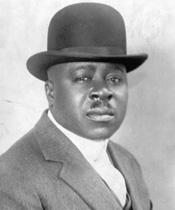Robert S. Abbott
| Robert Sengstacke Abbott | |
|---|---|

Abbott circa 1919
|
|
| Born |
November 24, 1870 St. Simons Island, Georgia, United States |
| Died | February 29, 1940 (aged 69) Chicago, Illinois, United States |
| Cause of death | Bright's disease |
| Resting place |
Lincoln Cemetery (Blue Island, Illinois) |
| Alma mater |
Hampton University Kent College of Law |
| Known for | Founder and publisher of The Chicago Defender newspaper and the Bud Billiken Parade and Picnic |
| Net worth | millionaire |
| Spouse(s) | 1) Helen Thornton Morrison (widow, 1918–1933, divorce) 2) Edna Brown Denison (widow, 1934 to his death) |
| Parent(s) | Flora Butler Thomas Abbott, stepfather John H. Sengstacke from the age of one year |
Robert Sengstacke Abbott (November 24, 1870 – February 29, 1940) was an African-American lawyer and newspaper publisher and editor. Abbott founded the The Chicago Defender newspaper, which grew to have the highest circulation of any black-owned newspaper in the country. An early adherent of the Bahá'í religion in the United States, he founded the Bud Billiken Parade and Picnic in 1929, which has developed as a celebration in Chicago of African-American life.
Abbot was born on November 24, 1870, in St. Simons Island, Georgia (although some sources state Savannah, Georgia) to freedman parents, who had been enslaved before the American Civil War. The Sea Islands were a place of the Gullah people, an African-descended ethnic group who continued stronger aspects of African cultures than among African Americans in other areas of the South. His father Thomas Abbott died when Robert was a baby.
His widowed mother Flora Abbott (née Butler) met and married John Sengstacke, an American mixed-race man of unusual background who had recently come to the US from Germany. His parents were Tama, a freed slave woman of African descent, and her husband Herman Sengstacke, a German sea captain who had a regular route from Hamburg to Savannah. In the Georgia port city in 1847, Herman saw a slave sale. He was so distressed he bought the freedom of Tama, a young woman from West Africa. They married in Charleston, South Carolina, before returning to Georgia, where their interracial marriage was prohibited. Their mixed-race son John was born the next year and a daughter in 1848. Tama died soon after their daughter was born, and Herman took the children back to Germany to be raised by family.
John met the young black widow Flora, who had a year-old son Robert. He cared for Robert as if he were his own. Together the couple had seven children together; their family crossed rigid racial boundaries. Robert was given the middle name Sengstacke to mark his belonging in the family. John Sengstacke had become a Congregationalist missionary as an adult; he wrote, "There is but one church, and all who are born of God are members of it. God made a church, man made denominations. God gave us a Holy Bible, disputing men made different kinds of disciples." Sengstacke became a teacher, determined to improve the education of black children. He also became a publisher, founding the Woodville Times, based in what was then a town named Woodville; it was later annexed by the city of Savannah, Georgia.
...
Wikipedia
